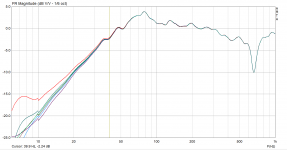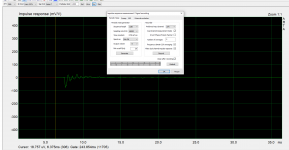Yes, I did. I remember doing the settings in the "measurement setup" window. And, as said, it generates until 80kHz (Steps is busy), but no actual signal at the output.Did you check the steps manual?
I haven't found anything in the manual, but all examples go to 20kHz only.
I am afraid that that is indeed the case. Can I do something about it? I like filters for my audio DACs, to protect the tweeters etc, but here I would be happy without it.your soundcard DAC output might filter >20k
There is some measurements of the soundcard here, I think I have to tweak...
https://www.diyaudio.com/community/threads/asus-xonar-u7-and-w10-apo-dsp-measurements.303078/
https://www.diyaudio.com/community/threads/asus-xonar-u7-and-w10-apo-dsp-measurements.303078/
DAC filters can be tricky, I suggest cirrus logic application note 048I am afraid that that is indeed the case. Can I do something about it? I like filters for my audio DACs, to protect the tweeters etc, but here I would be happy without it.
https://statics.cirrus.com/pubs/appNote/AN048Rev2.pdf
Simple removal will not help performance!
'Soundcard' distorsion measurements above 10k are not to be trusted anyways if you want my sincere opinion.
In this case I would also recommended using the ASIO drivers instead.Solved the "problem" - logical afterwards: setting the WDM driver to 192kHz for in- and output makes the output go to 80kHz with some rolloff.
You will never have these kind of issues again.
What is a good way to get rid of this awful D.C error (increase in frequency response from 30Hz downwards)?
I use a scarlett 2i2. together with Arta I just tested with a semi-dual setup by connecting right output with right input with XLR cable. I just had some time on my own in my living room and did test this, on a complete speaker looks ok, but also a lot of background noise with a lot of low frequency noise, so i am not sure. (do not mind the level, it is not correctly calibrated after fiddling with the input and output levels to reduce the influence of background noise.

I use a scarlett 2i2. together with Arta I just tested with a semi-dual setup by connecting right output with right input with XLR cable. I just had some time on my own in my living room and did test this, on a complete speaker looks ok, but also a lot of background noise with a lot of low frequency noise, so i am not sure. (do not mind the level, it is not correctly calibrated after fiddling with the input and output levels to reduce the influence of background noise.
Member
Joined 2003
Maybe Ivo could propose a good solution about ARTA's "inconsistency" when measuring very low frequencies.
Here below is an example of a near-field measurement of a subwoofer based on a 10" peerless woofer.
These are measurements taken consecutively (each one within seconds of the other) with the exact same setup. Every measurement is different below 40-50 Hz.
I know this is due to the very low frequencies, because if I put a passive high pass filter at 20 Hz at the microphone amplifier output, all the readings are exactly the same.
I have also monitor the output of the microphone amplifier in an oscilloscope and I saw very very low frequency signals, probably due to noises.
Is it possible to include a good solution for this in the software?
Here below is an example of a near-field measurement of a subwoofer based on a 10" peerless woofer.
These are measurements taken consecutively (each one within seconds of the other) with the exact same setup. Every measurement is different below 40-50 Hz.
I know this is due to the very low frequencies, because if I put a passive high pass filter at 20 Hz at the microphone amplifier output, all the readings are exactly the same.
I have also monitor the output of the microphone amplifier in an oscilloscope and I saw very very low frequency signals, probably due to noises.
Is it possible to include a good solution for this in the software?
Attachments
What sample rate are you measuring at, as well as FFT length?Maybe Ivo could propose a good solution about ARTA's "inconsistency" when measuring very low frequencies.
Here below is an example of a near-field measurement of a subwoofer based on a 10" peerless woofer.
These are measurements taken consecutively (each one within seconds of the other) with the exact same setup. Every measurement is different below 40-50 Hz.
I know this is due to the very low frequencies, because if I put a passive high pass filter at 20 Hz at the microphone amplifier output, all the readings are exactly the same.
I have also monitor the output of the microphone amplifier in an oscilloscope and I saw very very low frequency signals, probably due to noises.
Is it possible to include a good solution for this in the software?
This isexactly my point.They look pretty consistent to me. The red outlier might be caused by environmental noise. There is a lot of rumbling going on at infrasonic frequencies.
Is there a way to reject these very low frequencies (say below 3 Hz) by the Software?
B_force, thanks for the reply. Just having some time to spend on audio, so started looking into Arta, but cannot find what setting determines the time-bandwidth frequency. I looked into several measurements, and regardless of the setting during recording it is 50Hz. The Arta documentation does not give me any clues. What influences this, and is it worthwhile?Or just ignore it, since the time window sits at 50Hz,see the yellow line on the bottom of the graph.
So everything below 50Hz is garbage anyway.
Go to view -> time-bandwidth requirement.
Ah, found it Setup>analysis parameters. But is it worthwhile to set it to a lower frequency?
Last edited:
Member
Joined 2003
..... ARTA User manual page 88: General recommendations for impulse response measurement
https://artalabs.hr/download/ARTA-user-manual.pdf
https://artalabs.hr/download/ARTA-user-manual.pdf
This is also very good paper about kind of signal excitations and their reactions in different ambients
https://www.artalabs.hr/papers/im-aaaa2003.pdf
https://www.artalabs.hr/papers/im-aaaa2003.pdf

